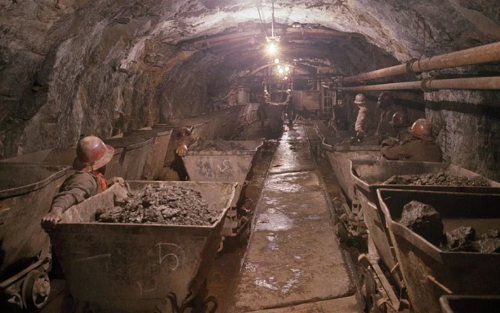In 1944, the United States learned that the fate of nations can hinge on a single hole in the ground.
From the heart of the Belgian Congo, the Shinkolobwe mine shipped uranium so pure it fueled the Manhattan Project — the spark that ended one war and started another.
It was proof that a single deposit, in the right hands, at the right time, could rewrite the world order.

Today, that lesson still rings true more than 80 years later.
Except this time, the race isn’t for uranium. The most powerful nations on Earth are in a frenzy to secure critical minerals — the rare earths, lithium, and cobalt that make fighter jets fly, EVs hum, and AI servers breathe.
And once again, the United States finds itself scrambling to secure the supply lines that will decide who will dominate the next century.
The New Mineral Arms Race
The headlines of the past month tell us the story clearly: the U.S. is no longer asking for access…
Trump is BUYING it!
You see, President Trump’s recent tour through Asia wasn't for diplomacy, it was all about acquisition.
Over the course of his trip, he signed a flurry of bilateral mineral agreements with Malaysia, Thailand, and Japan — plus a multi-billion-dollar framework with Australia to jointly finance mines, refineries, and processing plants.
Believe me, these weren’t photo ops.
Why? Because China still holds the high ground.
The Best Free Investment You’ll Ever Make
Our analysts have traveled the world over, dedicated to finding the best and most profitable investments in the global energy markets. All you have to do to join our Energy and Capital investment community is sign up for the daily newsletter below.
Remember, President Xi’s empire controls roughly 90% of global rare earth refining, and nearly all production of heavy rare earth magnets — the invisible backbone of modern industry.
If that sounds familiar, just think of it the same way that OPEC once held complete control over oil (and soon will again!); only this time, the U.S. can’t drill its way out… or can we?
President Trump’s counter punch so far has been a hard shift from policy to possession:
- Equity stakes: The U.S. is considering ownership positions in companies like Critical Metals and Trilogy Metals, turning grants into government shareholdings.
- Defense-backed financing: New deals include credit lines and offtake guarantees through EXIM, DoD, and DFC programs.
- Friend-shoring: Partner nations like Malaysia are on board — but insist on keeping value-added processing at home, meaning the U.S. must build entire supply chains, not just mines.
Like I said, the message is clear.
For the first time in decades, the United States isn’t just talking about resource security — it’s writing checks to make it real.
Even our allies understand the stakes, too.
Malaysia, for example, agreed to cooperate but refused to export unprocessed ore.
That’s the new game, dear reader — the race for raw material has evolved into a refining war, and the U.S. is starting late.
But hey, everyone has to start somewhere, right?
And the markets are starting to notice.
When news of these trade deals broke, rare earth stocks spiked across exchanges, echoing the same panic and promise that followed China’s 2010 export ban on Japan.
And every single headline since has reinforced the one major point — a single diplomatic tremor can freeze global production lines overnight.
The Golden Opportunity Tied to the Resource War
Look, the government can ink agreements all day, but it’ll be individual investors like us who make these mines real — and that’s where this story turns profitable.
Critical minerals aren’t just a national priority; they’re a once-in-a-generation investment window.
Every White House deal and defense-backed purchase program channels money toward one group of companies — the U.S.-based miners with verifiable in-ground reserves, proven metallurgy, and most important… a path to production.
However, the smart money is chasing more than just rare earth opportunities.
It’s chasing the rare balance among domestic players that blend future-facing assets with current cash flow.
And today, with gold prices gathering strength around 4,000/oz, that value is locked tightly in gold-backed miners with strong REE exposure.
Gold is the ballast in this storm.
We’re staring at the perfect pairing, and a single company with both in its portfolio offers insulation against policy risk, as well as massive upside from two converging bull markets.
That’s exactly the kind of setup we’re watching now.
This is the way to own the next Shinkolobwe before the world realizes it’s digging for history all over again.
Still looking?
Well, let me show you the best place to start your search.
Until next time,

Keith Kohl
A true insider in the technology and energy markets, Keith’s research has helped everyday investors capitalize from the rapid adoption of new technology trends and energy transitions. Keith connects with hundreds of thousands of readers as the Managing Editor of Energy & Capital, as well as the investment director of Angel Publishing’s Energy Investor and Technology and Opportunity.
For nearly two decades, Keith has been providing in-depth coverage of the hottest investment trends before they go mainstream — from the shale oil and gas boom in the United States to the red-hot EV revolution currently underway. Keith and his readers have banked hundreds of winning trades on the 5G rollout and on key advancements in robotics and AI technology.
Keith’s keen trading acumen and investment research also extend all the way into the complex biotech sector, where he and his readers take advantage of the newest and most groundbreaking medical therapies being developed by nearly 1,000 biotech companies. His network includes hundreds of experts, from M.D.s and Ph.D.s to lab scientists grinding out the latest medical technology and treatments. You can join his vast investment community and target the most profitable biotech stocks in Keith’s Topline Trader advisory newsletter.





